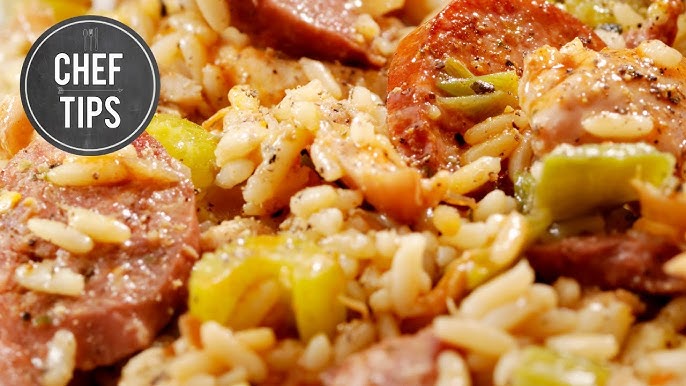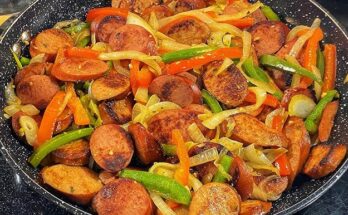Jambalaya Recipe: Jambalaya is a quintessential Southern dish, combining bold flavors, rich spices, and hearty ingredients. Whether you’re a fan of Cajun or Creole cuisine, this one-pot wonder brings together rice, meats, seafood, and vegetables in a flavorful harmony that’s hard to resist. It’s a perfect dish for family gatherings, a casual weeknight dinner, or even a festive occasion.
But what exactly is jambalaya? The dish has deep roots in Louisiana, with two primary styles: Cajun and Creole. Creole jambalaya typically includes tomatoes, while Cajun versions omit them. Regardless of which style you choose, the result is a filling, flavorful dish with smoky, spicy, and savory notes.
Ingredients for Jambalaya
For this step-by-step recipe, we’ll be using a combination of chicken, sausage, and shrimp, along with vegetables and spices to create an authentic jambalaya.
Essential Proteins:
- Chicken thighs: Tender, juicy, and packed with flavor.
- Andouille sausage: A spicy, smoked sausage that adds depth.
- Shrimp: Adds a seafood element, which is common in Creole-style jambalaya.
Vegetables and Aromatics:
- Onion: A key ingredient for sweetness.
- Bell peppers: Adds a crunchy texture.
- Celery: Part of the “Holy Trinity” of Louisiana cooking.
- Garlic: Because every good dish needs garlic.
Spices and Seasonings:
- Cajun seasoning: Adds heat and complex spice.
- Paprika, thyme, and bay leaves: For aroma and depth of flavor.
- Salt, pepper, and cayenne pepper: For that extra kick.
Rice:
- Long-grain rice: The staple of jambalaya. It absorbs the flavors and holds the dish together.
Equipment You’ll Need
Before starting, make sure you have the right tools:
- A large, heavy-bottomed pot (like a Dutch oven) for even cooking.
- A sharp knife for chopping vegetables and proteins.
- A wooden spoon for stirring.
The heavy pot is key here because it distributes heat evenly and allows the flavors to meld perfectly.
How to Make Jambalaya
You’ll find the full, step-by-step recipe below – but here’s a brief overview of what you can expect when you make this tried-and-true chicken and sausage jambalaya:
Step 1: Preparing the Proteins
Start by preparing your meats.
- Brown the chicken and sausage: Heat a little oil in your pot over medium-high heat. Add the chicken thighs and sausage slices, cooking until browned on both sides (about 5 minutes). Browning locks in flavor and creates a base for the rest of the dish. Remove the meats and set aside.
- Prepare the shrimp: Pat the shrimp dry with a paper towel and season them lightly with salt and pepper. Set aside for later.
Step 2: Chopping the Vegetables
Next, chop the vegetables.
- Dice onions, bell peppers, and celery. This trio is known as the “Holy Trinity” in Louisiana cooking, providing a flavor base for the dish.
- Mince the garlic.
Step 3: Cooking the Aromatics
Now, sauté the vegetables:
- In the same pot you used for the meats, add a little more oil if necessary.
- Sauté the onions, celery, and bell peppers until they’re softened (about 5 minutes).
- Add the garlic and cook for another minute, until fragrant.
Step 4: Adding the Rice
Now it’s time to add the rice.
- Pour in long-grain rice and stir it into the vegetables. Let it toast for a couple of minutes. Toasting the rice helps it absorb the flavors and prevents it from becoming too mushy.
Step 5: Incorporating Liquids
- Add in your liquids—typically chicken stock or broth. For Creole-style jambalaya, you’ll also add tomato sauce or crushed tomatoes.
- Stir everything together, ensuring that all ingredients are mixed evenly.
Step 6: Bringing It All Together
Now, return the browned chicken and sausage to the pot. Stir them into the rice and vegetable mixture, making sure everything is well-coated.
Step 7: Simmering the Jambalaya
Lower the heat to a simmer and cover the pot. Cook for about 20-25 minutes, stirring occasionally to prevent sticking. This allows the rice to absorb the liquids and all the flavors to blend beautifully.
Step 8: Adding the Shrimp
Once the rice is nearly cooked, it’s time to add the shrimp.
- Nestle the shrimp into the pot, spreading them out evenly.
- Cover the pot again and cook for an additional 5-7 minutes, or until the shrimp turn pink and are cooked through. Be careful not to overcook them.
Step 9: Seasoning to Taste
Taste the jambalaya and adjust the seasoning as needed. You might want to add more salt, pepper, or cayenne depending on how spicy you like your food.
Step 10: Serving Your Jambalaya
When the jambalaya is done, fluff the rice with a fork. Garnish with freshly chopped parsley or green onions for a burst of color and freshness.
Serve with a slice of crusty bread or a side of cornbread. A squeeze of lemon juice over the shrimp can also brighten the flavors.
Tips for Making the Perfect Jambalaya
- Don’t over-stir while the rice is cooking, as it can turn mushy.
- Adjust the heat level to your preference—Cajun food is typically spicy, but you can go mild if that suits you better.
- For a smokier flavor, try using smoked paprika or a few drops of liquid smoke.
Serving Suggestions
Garnishing Jambalaya
Top your jambalaya with fresh parsley or green onions for a pop of color and freshness.
Best Side Dishes to Pair With Jambalaya
Cornbread, hush puppies, or a simple green salad pair perfectly with jambalaya, balancing out the spiciness.
Common Mistakes to Avoid
Overcooking the Rice
Be careful not to overcook the rice. Turn off the heat when it’s just done, as residual heat will continue cooking it.
Not Balancing the Spice Levels
Jambalaya is meant to be flavorful but not overwhelmingly spicy. Adjust your seasoning throughout the cooking process for a balanced taste.
FAQs about Jambalaya Recipe
What is Jambalaya?
Jambalaya is a flavorful, one-pot dish originating from Louisiana, blending rice, meat (usually chicken or sausage), and seafood with Cajun or Creole seasonings.
What ingredients are essential in Jambalaya?
Key ingredients include rice, chicken, sausage, shrimp, tomatoes, onions, bell peppers, celery, and a variety of spices like cayenne pepper and paprika.
Is Jambalaya spicy?
Traditionally, Jambalaya has a mild to medium spice level. You can adjust the heat by adding or reducing cayenne pepper and hot sauce to match your taste.
Can Jambalaya be made ahead of time?
Yes, Jambalaya can be prepared ahead of time and reheats well, making it a convenient dish for meal prep or gatherings.
What’s the difference between Cajun and Creole Jambalaya?
Cajun Jambalaya usually doesn’t include tomatoes, while Creole Jambalaya features tomatoes, giving it a slightly sweeter flavor.
How do I store and reheat Jambalaya?
Store Jambalaya in an airtight container in the refrigerator for up to 3 days. Reheat it on the stove or microwave, adding a splash of water or broth to keep the rice moist.
Can I freeze Jambalaya?
Yes, Jambalaya freezes well. Place it in a freezer-safe container for up to 3 months. Thaw overnight in the refrigerator before reheating.
What side dishes go well with Jambalaya?
Jambalaya pairs well with cornbread, garlic bread, or a simple green salad for a balanced meal.
Conclusion
Jambalaya is the perfect comfort dish because it combines rich, bold flavors with hearty ingredients like rice, sausage, and seafood. Its versatility allows for endless variations, making it easy to adapt to your preferences or what’s available in your pantry.
Whether you’re cooking for a crowd or preparing a cozy meal at home, Jambalaya is sure to satisfy. Don’t be afraid to experiment with different proteins, seasonings, or veggies to create your own signature version of this beloved dish.
Give it a try today, and discover why Jambalaya is a timeless favorite!
References
For further reading and to validate the information provided in this Jambalaya Recipe, it’s essential to consult reputable sources. Trusted food blogs, recipe websites, and culinary experts can offer additional insights and variations of the dish. Here are some references for expanding your knowledge and perfecting your Jambalaya recipe:
- Food Network for classic Cajun and Creole recipes.
- Serious Eats for in-depth articles and cooking techniques.
- Allrecipes for user-generated recipes with ratings and reviews.
These sources provide reliable content to enhance your Jambalaya cooking experience.



